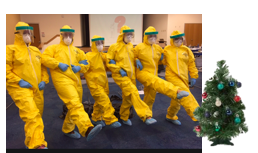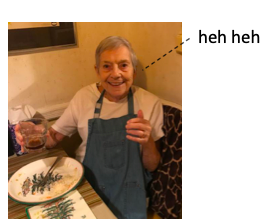
One month from her 93rd birthday and five feet tall (when standing on a 3" step), my mother does not appear to be especially threatening. Yet, as my family would find out, bioterrorists can come in small packages.
Although I have no hard evidence that my Mom actively tried to exterminate her family I don't think we can categorically dismiss this possibility. Something was going on because, intentionally or otherwise, she did quite a number on the collective family microbiome.
The Bloom household had two unwelcome guests for the holidays. One was an old friend who flew in from California to mooch off stay in her Manhattan apartment. The other was the norovirus infection he was unknowingly carrying in his small intestine. (Had American Airlines known this, don't you think they would have charged him extra for a carry-on virus?)
Here's the timeline...
- Day 1 - Unwanted visitor arrives.
- Days 2-3 - He suffers from various forms of gastrointestinal disquietude.
- Day 4 - Family becomes alarmed. Christmas dinner is postponed. Three options are considered: 1) Wait a few days and then go to Mom's for Xmas dinner; 2) Wait til next year; 3) Incinerate apartment. Option #1 prevailed (barely) over #3. Waiting a couple of extra days should be fine, right?
- No.
- Day 5 - Family assembles for festivities

Photo: Haggerty Consulting
But one unnamed individual fails to take adequate precautions...

She will pay dearly for this lapse in judgment.
- Day 6 - While those of us who utilized proper precautions are fine, she is anything but. Twenty-three hours after entering the Ebola Zone (average is 12-48, mean is 33) gastrointestinal hell breaks loose.

- Days 7-8 - Guest from hell leaves. All is quiet. Victim slowly recovers. Fortunately, this is over.
- No, it's not.
- Day 9 - Both aides are simultaneously struck down while bioterrorist cheerfully enjoys life.

- She never catches the bug.
Innocent looking, yes. Evil? Perhaps.
SCIENCE TIME: WHAT THE HELL HAPPENED?
How can it be that a 93-year old woman managed to be living at Norovirus Ground Zero for nearly a week yet came away unscathed, while four others, presumably with stronger immune systems, were doing their best Mt. Vesuvius imitations? Was it just dumb luck? Maybe not.
In the world of viral gastroenterology, there are "haves," and "have-nots." The "haves" have Type A blood and are much less likely to become infected than the "have-nots" – those with Type O, who not only are more likely to catch it but get sicker when they do. (See Do You Get The Stomach Bug While Others Dodge It? It Could Be Your Blood).
But immunity to norovirus involves more than just blood type. There is a small, lucky group called "asymptomatic carriers" who become infected, develop no symptoms, AND can pass the bug to others. This cannot be explained simply by blood type; 34% of people in the U.S. have Type A blood (1), but the number of asymptomatic carriers is considerably lower.
A 2016 study published in the Journal of Clinical Virology identified 94 patients in a hospital setting who had confirmed norovirus (this is done by analyzing stool samples). Of these, 85 (90%) developed norovirus symptoms but 9 (10%) did not.
A 2018 Lancet paper estimated that the worldwide prevalence of asymptomatic norovirus infection is about 7%.
Some very fortunate people simply do not get sick even when infected by one of the world's most contagious pathogens. But they are still full of the virus and can pass it on to others.
SO WHAT HAPPENED?
It's only an educated guess, but the following timeline explains how and when people succumbed.
- The guest from hell arrives and gets sick. My mother hangs around him while others in the apartment (her aides) avoid him like the plague.
- Except for one person during Christmas dinner who should have, but did not. You know the rest.
- My mother becomes infected at some point during this but has no symptoms. The danger period has passed. Her aides help care for her as usual.
- Except it hasn't. Two days later they both get it at exactly the same time, almost certainly from "Typhoid Marge."
- Although other theories about what went down (came up, actually) may be plausible, this mess can probably best be explained by my mother being an asymptomatic carrier of norovirus.
- Perhaps a more apt term would be "accidental bioterrorist."
While this is hardly a rigorous epidemiology study, the timeline at least makes sense. The guest from hell infected one person (who, by coincidence, is Type O) and my mother. He left and days later she infected two others, despite being perfectly healthy herself.
Presumably, this unfortunate episode will be sorted out by next Christmas. Cause I'm not going near that damn apartment till then.
Addendum:
(1) I now have less confidence in this statement. Although a 1994 clinical trial showed that people with Type A blood were resistant to the bug, a newer study claimed that types B and AB were the "chosen few." And neither of these may be correct because a 2015 review by the CDC concluded that no blood type provided any immunity. What to do with this information? I'd say throw up your hands in defeat but that would be in really poor taste.



